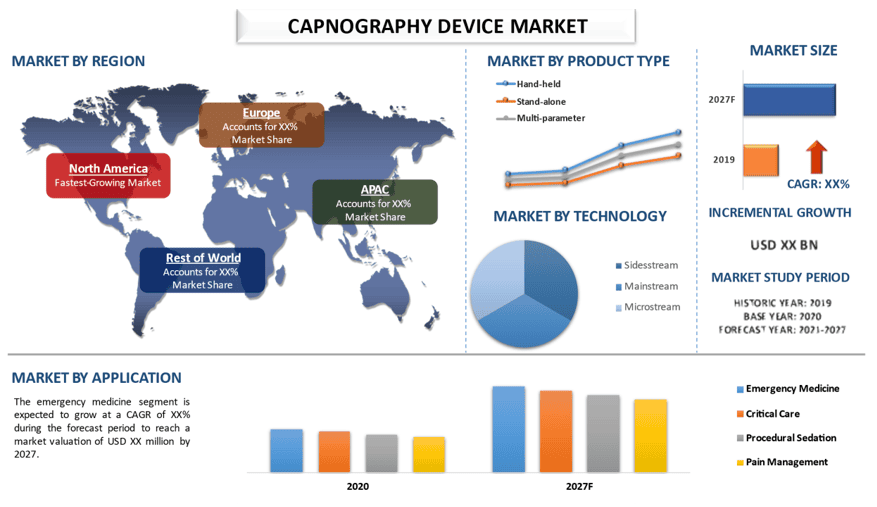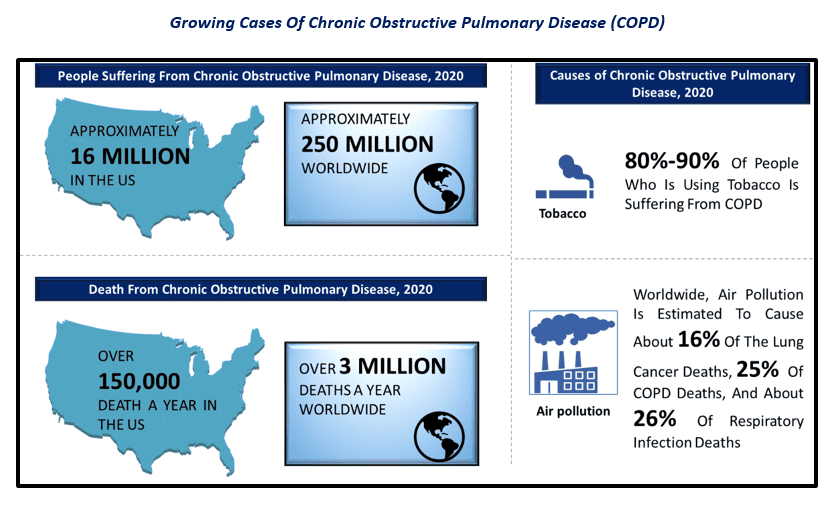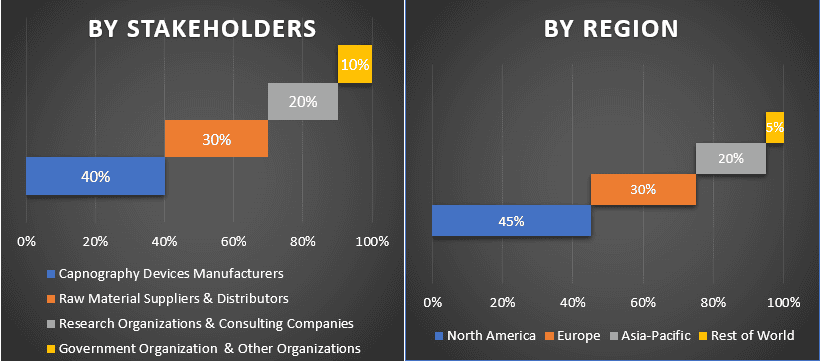- الرئيسية
- معلومات عنا
- صناعة
- الخدمات
- قراءة
- اتصل بنا
سوق أجهزة قياس ثاني أكسيد الكربون في نهاية الزفير: التحليل الحالي والتوقعات (2021-2027)
التركيز على نوع المنتج (محمول باليد، قائم بذاته، متعدد المعلمات)؛ التكنولوجيا (التدفق الجانبي، التدفق الرئيسي، التدفق الميكروي)؛ التطبيق (طب الطوارئ، الرعاية الحرجة، التخدير الإجرائي، إدارة الألم)؛ المستخدمون النهائيون (المستشفيات، مراكز الجراحة المتنقلة، آخرون)؛ المنطقة/الدولة

من المتوقع أن ينمو سوق أجهزة قياس ثاني أكسيد الكربون العالمية بمعدل نمو سنوي مركب مرتفع يبلغ حوالي 9٪ خلال الفترة المتوقعة (2021-2027). أجهزة قياس ثاني أكسيد الكربون هي أجهزة متطورة لمراقبة etCO2 تعمل على تبسيط مراقبة المرضى من خلال السماح للأطباء بقياس ثاني أكسيد الكربون الزفير الطرفي والعلامات الحيوية المتعددة على نفس الجهاز. يُستخدم قياس ثاني أكسيد الكربون بشكل أساسي لقياس تركيزات ثاني أكسيد الكربون في غاز الجهاز التنفسي لدراسة الأمراض التنفسية المختلفة وقياس مستوى ثاني أكسيد الكربون المنطلق في مجرى الدم بدقة. يعرض جهاز قياس ثاني أكسيد الكربون النتيجة بطريقة رسومية على الشاشة.
يمكن أن يُعزى التبني المتزايد لأجهزة قياس ثاني أكسيد الكربون إلى الارتفاع في انتشار الأمراض التنفسية المختلفة، وانسداد مجرى الهواء المركزي، ومرض الانسداد الرئوي المزمن، والربو، وما إلى ذلك إلى جانب النمو السريع في عدد كبار السن. وفقًا لمكتب الوقاية من الأمراض وتعزيز الصحة (ODPHP)، يوجد حاليًا أكثر من 25 مليون شخص في الولايات المتحدة مصابون بالربو. تم تشخيص ما يقرب من 14.8 مليون بالغ بمرض الانسداد الرئوي المزمن (COPD)، ولم يتم تشخيص ما يقرب من 12 مليون شخص بعد. مرض الانسداد الرئوي المزمن هو رابع سبب رئيسي للوفاة في الولايات المتحدة. هذه الزيادة في أمراض الجهاز التنفسي في السكان تخلق طلبًا على أجهزة قياس ثاني أكسيد الكربون. وبالتالي، تعزيز سوق أجهزة قياس ثاني أكسيد الكربون على مستوى العالم.
علاوة على ذلك، من المتوقع أن ينمو سوق أجهزة قياس ثاني أكسيد الكربون بسبب التقدم التكنولوجي المتزايد، وعدد كبير من الأنشطة البحثية الجارية في هذا المجال، والمزايا المختلفة مثل القراءة السريعة والدقيقة المرتبطة بأجهزة قياس ثاني أكسيد الكربون. تشمل بعض الفوائد الأخرى سياسات السداد المناسبة، والموثوقية والكفاءة العالية، والنتائج السريرية المرضية. ومع ذلك، تشمل بعض القيود في السوق الأطر التنظيمية الصارمة للمعدات والتكاليف المرتفعة للأجهزة التي تعيق نمو هذا السوق في جميع أنحاء العالم.

تعتبر Masimo وSmiths Medical وDragerwerk AG & Co. KGaA وWelch Allyn (Hill-Rom Holdings, Inc.) وKoninklijke Philips N.V. وMedtronic وNonin Medical, Inc. وNihon Kohden Corp. وBecton, Dickinson and Company وDiamedica Ltd. من بين اللاعبين البارزين العاملين في سوق أجهزة قياس ثاني أكسيد الكربون. لقد قام هؤلاء اللاعبون بالعديد من عمليات الاندماج والاستحواذ إلى جانب الشراكات لتسهيل حصول العملاء على أجهزة قياس ثاني أكسيد الكربون.
رؤى مقدمة في التقرير
"من بين أنواع المنتجات، يمتلك قطاع الأجهزة المحمولة باليد الحصة الأكبر"
استنادًا إلى نوع المنتج، يتم تقسيم سوق أجهزة قياس ثاني أكسيد الكربون إلى أجهزة محمولة باليد، ومستقلة، ومتعددة المعلمات. استحوذ قطاع الأجهزة المحمولة باليد على حصة سوقية كبيرة في عام 2020 ويقدر أنه سينمو بسرعة خلال الإطار الزمني المتوقع بسبب زيادة في تبني أجهزة قياس ثاني أكسيد الكربون المحمولة باليد بسبب المزايا المرتبطة بها مثل قابلية النقل العالية، وزيادة مستويات تشبع الأكسجين المطلوبة أثناء الجراحة، والمتانة العالية، والتكاليف المرتبطة المنخفضة. بالإضافة إلى ذلك، يتميز الجهاز المحمول باليد الذي تم تطويره حديثًا بإنذارات مرئية وصوتية وتقنية التدفق الجانبي.
"من بين التقنيات، يمتلك قطاع التدفق الجانبي الحصة الأكبر"
استنادًا إلى التكنولوجيا، يتم تقسيم سوق أجهزة قياس ثاني أكسيد الكربون إلى التدفق الجانبي، والتدفق الرئيسي، والتدفق الدقيق. احتل قطاع التدفق الجانبي الحصة الأكبر من سوق أجهزة قياس ثاني أكسيد الكربون في عام 2020 ومن المتوقع أن ينمو بمعدل نمو سنوي مركب كبير في السنوات القادمة. يُعزى نمو هذا القطاع إلى الطلب الكبير على مراقبة التخدير باستخدام هذه التقنية. علاوة على ذلك، تتمتع الأجهزة التي تدعم تقنية التدفق الجانبي بالعديد من المزايا مثل سهولة التوصيل وتقليل مشاكل التعقيم. تساعد هذه الأجهزة أيضًا في مراقبة المواد غير المحتضنة بمساعدة محولات الأنف.
"من بين التطبيقات، يمتلك قطاع طب الطوارئ الحصة الأكبر"
استنادًا إلى التطبيق، يتم تقسيم سوق أجهزة قياس ثاني أكسيد الكربون إلى طب الطوارئ، والرعاية الحرجة، والتخدير الإجرائي، وإدارة الألم. احتل قطاع طب الطوارئ الحصة الأكبر من سوق أجهزة قياس ثاني أكسيد الكربون في عام 2020 ومن المتوقع أن ينمو بمعدل نمو سنوي مركب كبير في السنوات القادمة. تُستخدم أجهزة قياس ثاني أكسيد الكربون على نطاق واسع في مراكز الطوارئ الطبية لتحسين التهوية قبل دخول المستشفى وإدارة حالات الطوارئ للأطفال، وكمؤشر تنبؤي لتدفق الدم الرئوي. علاوة على ذلك، فإن المجموعة الواسعة من تطبيقات هذه الأجهزة والمبادئ التوجيهية والتوصيات المتطورة لإدراج قياس ثاني أكسيد الكربون في طب الطوارئ تؤثر أيضًا بشكل إيجابي على نمو القطاع.
"من بين المستخدمين النهائيين، يمتلك قطاع المستشفيات الحصة الأكبر"
استنادًا إلى المستخدمين النهائيين، يتم تقسيم السوق إلى مستشفيات ومراكز جراحة العيادات الخارجية وغيرها. في عام 2020، استحوذ قطاع المستشفيات على حصة سوقية كبيرة، ومن المتوقع أن ينمو بمعدل نمو سنوي مركب كبير خلال الفترة المتوقعة بسبب الاستخدام المتزايد لهذه الأجهزة كإجراء وقائي لمعالجة الأحداث الحرجة في وحدات العناية المركزة.
"تمثل أمريكا الشمالية واحدة من أكبر أسواق سوق أجهزة قياس ثاني أكسيد الكربون"
لتحسين فهم ديناميكيات السوق لسوق أجهزة قياس ثاني أكسيد الكربون، تم إجراء تحليل مفصل لمناطق مختلفة في جميع أنحاء العالم بما في ذلك أمريكا الشمالية (الولايات المتحدة وكندا وبقية أمريكا الشمالية)، وأوروبا (ألمانيا وفرنسا وإسبانيا والمملكة المتحدة وإيطاليا وبقية أوروبا)، وآسيا والمحيط الهادئ (الصين والهند وأستراليا واليابان وبقية منطقة آسيا والمحيط الهادئ)، وبقية العالم. تشكل أمريكا الشمالية سوقًا رئيسيًا لصناعة سوق أجهزة قياس ثاني أكسيد الكربون وحققت إيرادات قدرها XX مليون دولار أمريكي في عام 2020 بسبب البنية التحتية القوية للرعاية الصحية والتبني المتزايد لأجهزة قياس ثاني أكسيد الكربون في المنطقة.
أسباب شراء هذا التقرير:
- تتضمن الدراسة تحليل حجم السوق والتنبؤ به تم التحقق منه من قبل خبراء الصناعة الرئيسيين الموثوقين
- يقدم التقرير مراجعة سريعة للأداء العام للصناعة في لمحة واحدة
- يغطي التقرير تحليلًا متعمقًا لأقران الصناعة البارزين مع التركيز الأساسي على البيانات المالية الرئيسية للأعمال، ومجموعة المنتجات، واستراتيجيات التوسع، والتطورات الأخيرة
- فحص مفصل للمحركات والقيود والاتجاهات الرئيسية والفرص السائدة في الصناعة
- تغطي الدراسة بشكل شامل السوق عبر قطاعات مختلفة
- تحليل متعمق على المستوى الإقليمي للصناعة
خيارات التخصيص:
يمكن تخصيص سوق أجهزة قياس ثاني أكسيد الكربون العالمية بشكل أكبر وفقًا للمتطلبات أو أي قطاع سوقي آخر. إلى جانب ذلك، تتفهم UMI أن لديك احتياجات عمل خاصة بك، لذا لا تتردد في التواصل معنا للحصول على تقرير يناسب متطلباتك تمامًا.
جدول المحتويات
منهجية البحث لتحليل سوق أجهزة قياس ثاني أكسيد الكربون العالمية (2021-2027)
كان تحليل السوق التاريخي، وتقدير السوق الحالي، والتنبؤ بسوق أجهزة قياس ثاني أكسيد الكربون العالمية في المستقبل هي الخطوات الرئيسية الثلاث التي تم اتخاذها لإنشاء وتحليل اعتماد أجهزة قياس ثاني أكسيد الكربون في المناطق الرئيسية على مستوى العالم. تم إجراء بحث ثانوي شامل لجمع أرقام السوق التاريخية وتقدير حجم السوق الحالي. ثانيًا، للتحقق من صحة هذه الرؤى، تم أخذ العديد من النتائج والافتراضات في الاعتبار. علاوة على ذلك، تم إجراء مقابلات أولية شاملة أيضًا مع خبراء الصناعة عبر سلسلة القيمة لسوق أجهزة قياس ثاني أكسيد الكربون العالمية. بعد افتراض أرقام السوق والتحقق من صحتها من خلال المقابلات الأولية، استخدمنا نهجًا تصاعديًا / تنازليًا للتنبؤ بحجم السوق الكامل. بعد ذلك، تم اعتماد طرق تقسيم السوق وتثليث البيانات لتقدير وتحليل حجم سوق القطاعات والقطاعات الفرعية التي تنتمي إليها الصناعة. يتم شرح المنهجية التفصيلية أدناه:
اطلب المزيد من التفاصيل حول منهجية البحث
تحليل حجم السوق التاريخي
الخطوة 1: دراسة متعمقة للمصادر الثانوية:
تم إجراء دراسة ثانوية تفصيلية للحصول على حجم السوق التاريخي لأجهزة قياس ثاني أكسيد الكربون من خلال مصادر الشركة الداخلية مثل التقرير السنوي والبيانات المالية، وعروض الأداء، والبيانات الصحفية، وما إلى ذلك، والمصادر الخارجية بما في ذلك المجلات والأخبار والمقالات والمنشورات الحكومية ومنشورات المنافسين وتقارير القطاعات وقاعدة بيانات الطرف الثالث والمنشورات الموثوقة الأخرى.
الخطوة 2: تجزئة السوق:
بعد الحصول على حجم السوق التاريخي لسوق أجهزة قياس ثاني أكسيد الكربون، أجرينا تحليلًا ثانويًا تفصيليًا لجمع رؤى السوق التاريخية وحصة القطاعات والقطاعات الفرعية المختلفة للمناطق الرئيسية. تشمل القطاعات الرئيسية المدرجة في التقرير نوع المنتج والتكنولوجيا والتطبيقات والمستخدمين النهائيين. تم إجراء المزيد من التحليلات على مستوى الدولة لتقييم الاعتماد الكلي لأجهزة قياس ثاني أكسيد الكربون في جميع أنحاء العالم.
الخطوة 3: تحليل العوامل:
بعد الحصول على حجم السوق التاريخي للقطاعات والقطاعات الفرعية المختلفة، أجرينا تحليل عوامل مفصل لتقدير حجم السوق الحالي للأوعية الدموية الاصطناعية. علاوة على ذلك، أجرينا تحليلًا للعوامل باستخدام متغيرات تابعة ومستقلة مثل التطورات المتزايدة في التكنولوجيا وزيادة انتشار أمراض الجهاز التنفسي. تم إجراء تحليل شامل لسيناريوهات الطلب والعرض مع مراعاة الشراكات الكبرى وعمليات الاندماج والاستحواذ وتوسيع الأعمال وإطلاق المنتجات في قطاع أجهزة قياس ثاني أكسيد الكربون في جميع أنحاء العالم.
تقدير حجم السوق الحالي والتنبؤ به
تحديد حجم السوق الحالي: بناءً على رؤى قابلة للتنفيذ من الخطوات الثلاث المذكورة أعلاه، توصلنا إلى حجم السوق الحالي واللاعبين الرئيسيين في سوق أجهزة قياس ثاني أكسيد الكربون والحصص السوقية للقطاعات. تم تحديد جميع تقسيمات الحصص المئوية المطلوبة وتقسيمات السوق باستخدام النهج الثانوي المذكور أعلاه وتم التحقق منها من خلال المقابلات الأولية.
التقدير والتنبؤ: لتقدير السوق والتنبؤ به، تم تخصيص أوزان لعوامل مختلفة بما في ذلك المحركات والاتجاهات والقيود والفرص المتاحة لأصحاب المصلحة. بعد تحليل هذه العوامل، تم تطبيق تقنيات التنبؤ ذات الصلة، أي النهج التصاعدي / التنازلي، للتوصل إلى توقعات السوق حول عام 2027 للقطاعات الفرعية والقطاعات الفرعية المختلفة في الأسواق الرئيسية على مستوى العالم. تشتمل منهجية البحث المعتمدة لتقدير حجم السوق على:
- حجم سوق الصناعة، من حيث القيمة (بالدولار الأمريكي) ومعدل اعتماد أجهزة قياس ثاني أكسيد الكربون في الأسواق الرئيسية محليًا
- جميع الحصص المئوية والانقسامات والتقسيمات للقطاعات الفرعية والقطاعات الفرعية
- اللاعبون الرئيسيون في سوق أجهزة قياس ثاني أكسيد الكربون من حيث المنتجات المعروضة. أيضًا، استراتيجيات النمو التي يتبناها هؤلاء اللاعبون للمنافسة في السوق سريع النمو
التحقق من صحة حجم السوق وحصته
البحث الأولي: تم إجراء مقابلات متعمقة مع قادة الرأي الرئيسيين (KOLs) بما في ذلك كبار المسؤولين التنفيذيين (CXO / VPs، ورئيس المبيعات، ورئيس التسويق، والرئيس التشغيلي، والرئيس الإقليمي، والرئيس القطري، وما إلى ذلك) عبر المناطق الرئيسية. ثم تم تلخيص نتائج البحوث الأولية وإجراء تحليل إحصائي لإثبات الفرضية المذكورة. تم دمج المدخلات من البحوث الأولية مع النتائج الثانوية، وبالتالي تحويل المعلومات إلى رؤى قابلة للتنفيذ.
تقسيم المشاركين الأساسيين في مناطق مختلفة

هندسة السوق
تم استخدام تقنية تثليث البيانات لإكمال تقدير السوق الإجمالي والتوصل إلى أرقام إحصائية دقيقة لكل قطاع فرعي وقطاع فرعي من سوق أجهزة قياس ثاني أكسيد الكربون. تم تقسيم البيانات إلى عدة قطاعات وقطاعات فرعية بعد دراسة المعايير والاتجاهات المختلفة في مجالات نوع المنتج والتكنولوجيا والتطبيق والمستخدمين النهائيين لسوق أجهزة قياس ثاني أكسيد الكربون.
الهدف الرئيسي لدراسة سوق أجهزة قياس ثاني أكسيد الكربون
تم تحديد اتجاهات السوق الحالية والمستقبلية لأجهزة قياس ثاني أكسيد الكربون في الدراسة. يمكن للمستثمرين اكتساب رؤى استراتيجية لترسيخ تقديرهم للاستثمارات من التحليل النوعي والكمي الذي تم إجراؤه في الدراسة. تم تحديد اتجاهات السوق الحالية والمستقبلية للجاذبية الكلية للسوق على المستوى الإقليمي، مما يوفر منصة للمشارك الصناعي لاستغلال السوق غير المستغل للاستفادة كميزة للمبادر الأول. تشمل الأهداف الكمية الأخرى للدراسات ما يلي:
- تحليل حجم السوق الحالي والمتوقع لأجهزة قياس ثاني أكسيد الكربون من حيث القيمة (بالدولار الأمريكي). أيضًا، قم بتحليل حجم السوق الحالي والمتوقع للقطاعات الفرعية والقطاعات الفرعية المختلفة
- تشمل القطاعات في الدراسة مجالات نوع المنتج والتكنولوجيا والتطبيق والمستخدمين النهائيين
- تحديد وتحليل الإطار التنظيمي لصناعة أجهزة قياس ثاني أكسيد الكربون
- تحليل سلسلة القيمة المتضمنة مع وجود وسطاء مختلفين، إلى جانب تحليل سلوكيات العملاء والمنافسين في الصناعة
- تحليل حجم السوق الحالي والمتوقع لسوق أجهزة قياس ثاني أكسيد الكربون للمنطقة الرئيسية
- تشمل المناطق الرئيسية التي تمت دراستها في التقرير أمريكا الشمالية وأوروبا وآسيا والمحيط الهادئ وبقية العالم
- ملفات تعريف الشركات في سوق أجهزة قياس ثاني أكسيد الكربون واستراتيجيات النمو التي يتبناها اللاعبون في السوق للاستمرار في السوق سريع النمو
- تحليل إقليمي متعمق للصناعة
ذات صلة التقارير
العملاء الذين اشتروا هذا المنتج اشتروا أيضًا










